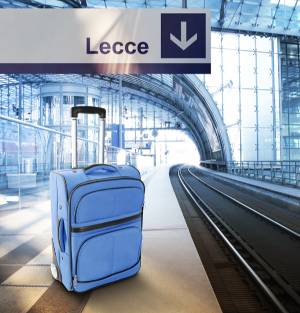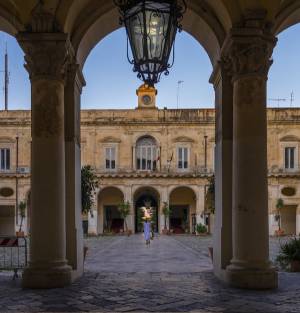One of the most charming cities in southern Italy, Lecce is located on the Salento peninsula in the Puglia region. Small enough to be explored by walking, the city enjoys a Mediterranean climate, with hot, dry summers and mild, wet winters. It lies between the Adriatic Sea to the east and the Ionian Sea to the west, which offer beautiful beaches with crystal clear waters, located just a few kilometers from the city, easily accessible by public transport and with personalized hotel transfer services.
Brief History
The city, originally known as Lupiae, was founded around 1200 BC and flourished under Roman rule, as evidenced by some remains in the historic center. After the fall of the Roman Empire, Lecce experienced various dominations, including Byzantine, Norman, Swabian and under the Kingdom of Naples, becoming a significant cultural and economic center.
Architecture
The historic centre of Lecce is a maze of narrow streets, baroque buildings, and charming squares. The local limestone, known as Pietra Leccese, is soft and easy to carve, allowing for intricate and elaborate designs. The city’s architecture is marked by ornate facades, detailed sculptures, and grandiose churches and palaces, for this reason it is known as the “Florence of the South”.
Places to visit
Piazza Sant’Oronzo. It is the largest square in the heart of the city, surrounded by numerous monuments with various architectural styles. Here you can admire:
- the Roman Amphitheatre: Built between the 1st and 2nd centuries, this amphitheatre, which once held up to 25,000 spectators, was unearthed in the 20th century during renovations to the square. Only part of it has been excavated, with the rest still buried under other buildings. During the day, it hosts tours that highlight its excellent preservation, while the evening illuminations make it a very evocative setting that hosts many performances;
- the Church of Santa Maria delle Grazie: Dating back to the 14th century, it is a striking example of pure Baroque architecture that stands opposite the Roman Amphitheatre;
- the Column of Sant’Oronzo: Originally marking the end of the Appian Way in Brindisi, this column topped by the imposing statue of Sant’Oronzo blessing, was donated to Lecce to honour its patron saint;
- the Sedile or Palazzo del Seggio, currently home to the Lecce tourist office, is a small building topped by a loggia and skilfully constructed blending Gothic and Renaissance styles.
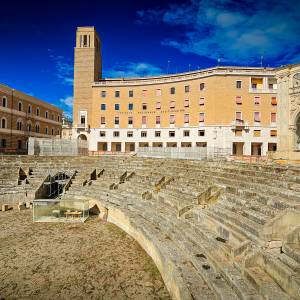
Charles V Castle: A Habsburg fortress originally built in the Middle Ages and significantly expanded in the 16th century under Emperor Charles V. The castle has a quadrilateral layout with four bastions and a moat and two ancient gates, Porta Reale and Porta Falsa, which once had drawbridges. Today, the Castle hosts the Papier-mâché Museum and other cultural exhibitions, events and guided tours.
Basilica di Santa Croce. Located in the heart of Lecce, this church was completed in 1646 and, along with the adjacent former Celestine Convent, represents the pinnacle of Lecce Baroque style. Inside, the basilica features several chapels adorned with beautiful artworks and a large altar, but it is most renowned for its intricately decorated facade with detailed sculptures, including cherubs, animals, and fantastical creatures, all meticulously carved in stone.
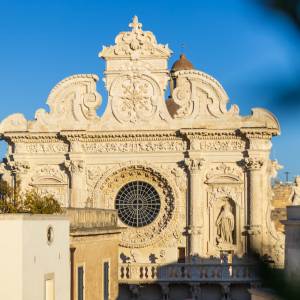
Piazza del Duomo. It is an example of a “closed square” with an unusual but harmonious arrangement of Baroque buildings, including the Cathedral of Santa Maria Assunta (the Duomo), the Campanile (bell tower), the Episcopio (Bishop’s Palace) and the Palazzo del Seminario, which create a theatrical atmosphere.
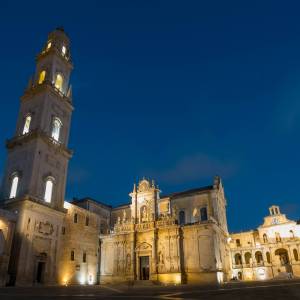
Porta Napoli: It is one of the three main gates of the city, alongside Porta San Biagio and Porta Rudiae. Porta Napoli was built in the 16th century to honor Emperor Charles V, as a single triumphal arch flanked by Corinthian columns and a triangular pediment adorned with the imperial Habsburg coat of arms.
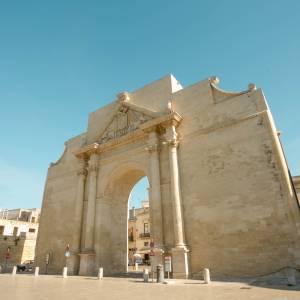
Green areas: The Belloluogo park that gravitates around the Belloluogo Tower delimited by a deep moat, built between the 13th and 14th centuries; Villa Comunale, a beautiful public garden perfect for a relaxing stroll.
The traditions
The culture of Salento is a fascinating mix of traditions, art and history. Salento is known for its musical heritage, in particular the Pizzica, a popular dance with roots in the ancient rituals of Tarantism. Traditionally, it was believed to cure the bite of the tarantula spider to which peasants working in the fields were subject. Accompanied by fast-paced music featuring tambourines, violins, and guitars, the pizzica creates an infectious rhythm, forced the “patients” to energetic movements capable of eliminating the spider poison from the body. Today it symbolizes the rich cultural heritage of Salento and is celebrated at the annual festival La Notte della Taranta, an event that attracts thousands of visitors, presenting both traditional and contemporary interpretations of the dance.
Salento cuisine
Salento boasts a rich culinary tradition that reflects its history and geography. The cuisine is characterized by simple but tasty and creative dishes, made with locally sourced ingredients.
The “Sagne ‘Ncannulate“, a fresh pasta with a very particular twisted shape, often served with a rich tomato and ricotta sauce. Fresh fish is always present in restaurants, in fact it is typical to eat the “Polpo alla pignata“, seasoned with a tomato sauce, strictly cooked over a low heat in a terracotta pot that gives it a unique flavor. A typical dish of the peasant tradition is the “Ciceri e tria“, a mix of fresh pasta and fried pasta topped with chickpeas.
Popular street foods are the “Rustico Leccese“, a puff pastry filled with mozzarella, béchamel and tomato, and the “Puccia Salentina“, a type of sandwich made with a soft and round bread to be stuffed with local delicacies.
… and finally, the typical dessert “Pasticciotto“, created in 1745 by a brilliant pastry chef who had the idea of using shortcrust pastry scraps and filling them with custard, creating a plump, delicious and irresistible dessert.
In the historic center of Lecce there are various pizzerias and Osteria-type restaurants that are nice and affordable … look here.
ph. Pierpaolo Schiavone











